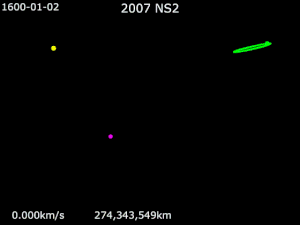2007 NS2
小行星
2007 NS2是一顆位於火星後方60度的L5點上的一顆小行星。
| 發現[1] | |
|---|---|
| 發現地 | 薩拉天文台 |
| 發現日期 | July 14, 2007年7月14日 |
| 編號 | |
| 小行星分類 | Martian L5  |
| 軌道參數[2][3] | |
| 曆元 2013年4月18日 (JD 2456400.5) | |
| 遠日點 | 1.6060339 AU |
| 近日點 | 1.4413971 AU |
| 半長軸 | 1.5237155 AU |
| 離心率 | 0.0540248 |
| 軌道週期 | 686.9960633 d 1.88 yr |
| 平近點角 | 225.47063° |
| 軌道傾角 | 18.62167° |
| 升交點黃經 | 282.49888° |
| 近日點參數 | 176.93881° |
| 物理特徵 | |
| 大小 | 800–1600 m |
| 絕對星等(H) | 17.8 |

太陽 · 2007 NS2 · 火星
發現、軌道和物理特徵
編輯2007 NS2是在2997年7月14日被薩拉天文台(Observatorio Astronómico de La Sagra)發現的[4][5][6][7][8]。它的軌道特徵是低離心率(0.054),中等程度的軌道傾角(18.6º)和1.52天文單位的軌道半長軸[8]。發現之後,被小行星中心歸類為穿越火星者。它目前的軌道(2013年3月)是依據跨越4,800天弧長中的87次測量決定的[9]。2007 NS2的絕對星等是17.8,依據特徵推斷它的直徑是870米[9]。
火星特洛伊和軌道演化
編輯Jean Meeus在2012年確認了Reiner Stoss在MPC資料庫中從1998年起的軌道分析,懷疑2007 NS2是一顆火星的特洛伊小行星[10]。在2012年確認它是火星洛特伊的成員之一[11]。最近的計算確認這是一顆位於L5的穩定火星特洛伊,有著週期1,310年、振幅14º的擺動[12][13]。在所有已知的火星特洛伊,它有著相對於火星差距最小的半長軸,只有0.000059天文單位[12]。
起源
編輯長期的數值積分顯示它的軌道在數十億年的時間尺度下是非常穩定的。如同(5261) 尤里卡,計算顯示無論在45億年前或45億年後,2007 NS2仍是原始的天體,或許它是在太陽系的早期歷史中,在類地行星誕生與形成範圍內倖存的微行星[12]。
火星特洛伊
編輯L4 :
L5 :
候選者:
參考資料
編輯- ^ Major News About Minor Objects. July 16, 2007 [April 22, 2009]. (原始內容存檔於2019-08-06).
- ^ Template:Cite sbdb
- ^ AstDys-1. [2013-09-29]. (原始內容存檔於2012-06-05).
- ^ 2007 NS2 discovery blog. [2013-09-29]. (原始內容存檔於2020-07-24).
- ^ Discovery MPEC. [2013-09-29]. (原始內容存檔於2016-03-04).
- ^ Update MPEC. [2013-09-29]. (原始內容存檔於2013-10-03).
- ^ New Scientist article on the discovery. [2013-09-29]. (原始內容存檔於2013-12-03).
- ^ 8.0 8.1 MPC data on 2007 NS2. [2013-09-29]. (原始內容存檔於2016-03-03).
- ^ 9.0 9.1 JPL's Solar System Dynamics data on 2007 NS2
- ^ 存档副本. [2013-09-29]. (原始內容存檔於2013-11-12).
- ^ Schwarz, R.; Dvorak, R. Trojan capture by terrestrial planets. Celestial Mechanics and Dynamical Astronomy. 2012, 113 (1): 23. Bibcode:2012CeMDA.113...23S. doi:10.1007/s10569-012-9404-4.
- ^ 12.0 12.1 12.2 de la Fuente Marcos, C.; de la Fuente Marcos, R. Three new stable L5 Mars Trojans. Monthly Notices of the Royal Astronomical Society Letters. 2013, 432 (1): L31–L35. Bibcode:2013MNRAS.432L..31D. arXiv:1303.0124 . doi:10.1093/mnrasl/slt028.
- ^ Christou, A. A. Orbital clustering of Martian Trojans: An asteroid family in the inner solar system?. Icarus. 2013, 224 (1): 144–153. Bibcode:2013Icar..224..144C. arXiv:1303.0420 . doi:10.1016/j.icarus.2013.02.013.
- Further reading
- Rodriguez, J.; et al.. 2007 NS2. Minor Planet Electronic Circular. 2007: 2007–0303. Bibcode:2007MPEC....O...03R.
- Skiff, B. A.; et al.. 2007 NS2. Minor Planet Electronic Circular. 2007: 2007–O09. Bibcode:2007MPEC....O...09S.
- Schwarz, R.; Dvorak, R. Trojan capture by terrestrial planets. Celestial Mechanics and Dynamical Astronomy. 2007, 113 (1): 23. Bibcode:2012CeMDA.113...23S. doi:10.1007/s10569-012-9404-4.
- de la Fuente Marcos, C.; de la Fuente Marcos, R. Three new stable L5 Mars Trojans. Monthly Notices of the Royal Astronomical Society Letters. 2013, 432 (1): L31. Bibcode:2013MNRAS.432L..31D. arXiv:1303.0124 . doi:10.1093/mnrasl/slt028.
- Christou, A. A. Orbital clustering of martian Trojans: An asteroid family in the inner Solar System?. Icarus. 2007, 224 (1): 144. Bibcode:2013Icar..224..144C. arXiv:1303.0420 . doi:10.1016/j.icarus.2013.02.013.